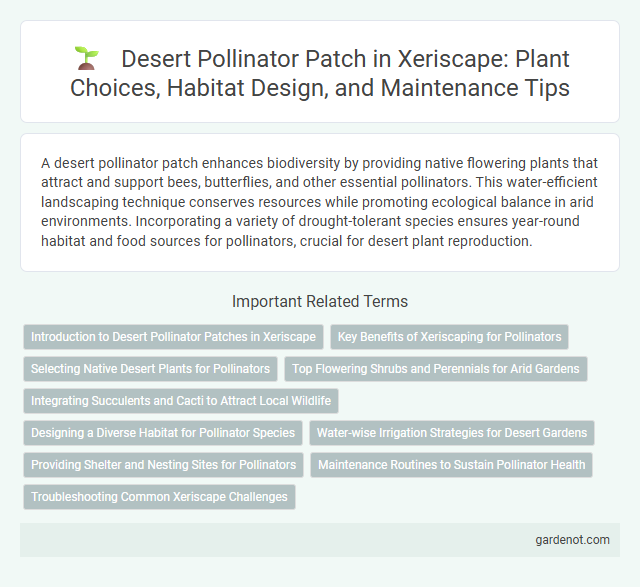A desert pollinator patch enhances biodiversity by providing native flowering plants that attract and support bees, butterflies, and other essential pollinators. This water-efficient landscaping technique conserves resources while promoting ecological balance in arid environments. Incorporating a variety of drought-tolerant species ensures year-round habitat and food sources for pollinators, crucial for desert plant reproduction.
Introduction to Desert Pollinator Patches in Xeriscape
Desert pollinator patches play a crucial role in supporting local biodiversity by providing native flowering plants that attract and sustain essential pollinators such as bees, butterflies, and hummingbirds. These patches use drought-tolerant species adapted to arid climates, reducing water consumption while enhancing ecological balance in xeriscape landscapes. Incorporating desert pollinator patches promotes habitat restoration and encourages healthy pollination, vital for maintaining desert ecosystems and improving garden productivity.
Key Benefits of Xeriscaping for Pollinators
Xeriscaping with desert pollinator patches supports local pollinators by providing native, drought-tolerant flowering plants that produce abundant nectar and pollen resources throughout the year. This sustainable landscaping reduces water consumption while enhancing pollinator habitats, thus promoting biodiversity and resilience in arid environments. Creating xeriscape pollinator patches also minimizes the need for chemical fertilizers and pesticides, fostering healthier ecosystems for bees, butterflies, and other beneficial insects.
Selecting Native Desert Plants for Pollinators
Selecting native desert plants for a desert pollinator patch enhances biodiversity by providing essential nectar and pollen resources specifically adapted to local pollinators. Species such as desert milkweed, penstemon, and creosote bush attract bees, butterflies, and hummingbirds, supporting ecosystem health and stability. Native plants reduce water usage and require minimal maintenance, making them ideal for sustainable xeriscaping designed to boost pollinator populations.
Top Flowering Shrubs and Perennials for Arid Gardens
Top flowering shrubs like Texas sage (Leucophyllum frutescens) and desert broom (Baccharis sarothroides) attract vital pollinators such as bees and butterflies in xeriscape desert gardens. Perennials including blanket flower (Gaillardia pulchella) and desert milkweed (Asclepias subulata) provide continuous nectar sources while thriving in arid conditions. These plants boost biodiversity and support native pollinator populations essential for maintaining healthy, sustainable desert ecosystems.
Integrating Succulents and Cacti to Attract Local Wildlife
Desert pollinator patches thrive by integrating drought-tolerant succulents and cacti, which provide essential nectar and habitat for native bees, butterflies, and hummingbirds. Succulents such as Agave and Sedum, along with cacti like Prickly Pear and Barrel, offer seasonal blooms that support pollinator populations in arid landscapes. This sustainable planting approach conserves water while promoting biodiversity and enhancing local ecosystems in xeriscape gardens.
Designing a Diverse Habitat for Pollinator Species
Designing a desert pollinator patch involves selecting a variety of native, drought-tolerant plants that bloom at different times to provide continuous nectar sources for bees, butterflies, and hummingbirds. Incorporating species such as desert milkweed, penstemon, and globe mallow creates a resilient habitat that supports diverse pollinator populations. Strategic placement of host plants and water features enhances shelter and hydration, promoting pollinator health and biodiversity in xeriscape landscapes.
Water-wise Irrigation Strategies for Desert Gardens
Implementing water-wise irrigation strategies in desert pollinator patches enhances plant health while conserving scarce water resources. Drip irrigation systems deliver precise moisture directly to the root zones of native desert plants, minimizing evaporation and runoff. Scheduling irrigation during early morning or late evening further reduces water loss, supporting sustainable maintenance of pollinator-friendly desert gardens.
Providing Shelter and Nesting Sites for Pollinators
Desert pollinator patches are specifically designed to offer essential shelter and nesting sites for native pollinators such as bees, butterflies, and hummingbirds. These patches incorporate diverse native plants, hollow stems, and bare soil areas that cater to the nesting behaviors of solitary bees and other beneficial insects. Providing these habitats supports pollinator populations, promoting biodiversity and enhancing the health of xeriscape gardens in arid environments.
Maintenance Routines to Sustain Pollinator Health
Effective maintenance routines for desert pollinator patches include regular watering schedules aligned with drought-tolerant plant needs to prevent overhydration and promote deep root growth. Periodic removal of invasive species and dead plant material supports native pollinators by maintaining habitat quality and reducing pest outbreaks. Monitoring for pollinator activity and plant health ensures timely interventions, fostering a resilient ecosystem critical for sustaining pollinator populations in xeriscape environments.
Troubleshooting Common Xeriscape Challenges
Desert pollinator patches can face challenges such as limited water availability, soil compaction, and pest management when integrated into xeriscape designs. Ensuring proper soil aeration, selecting native drought-tolerant plants like desert milkweed and penstemon, and implementing organic pest control methods support pollinator health and habitat sustainability. Monitoring soil moisture and adjusting irrigation schedules optimize water efficiency while enhancing pollinator activity in arid landscapes.
Desert pollinator patch Infographic

 gardenot.com
gardenot.com